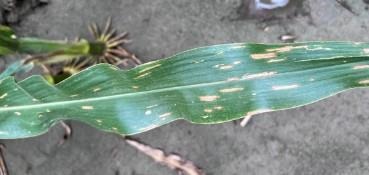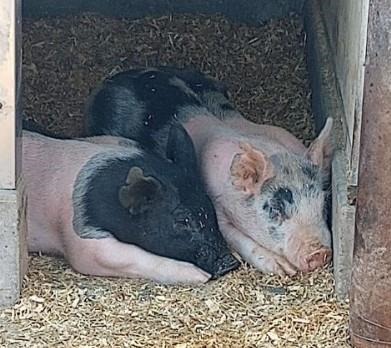- Ability to continually apply the optimum amount of nutrients required, resulting in healthier plants and higher yields.
- Ease of application. The irrigation system and the injector distribute the fertilizer.
- By applying fertilizer directly to the crop and eliminating waste to row middles, growers can achieve optimum yields while using less fertilizer.
Water Availability and Quality
Irrigation water is a necessity for high tunnel production systems. Water sources may include wells, public water systems, harvested water, and surface water. The amount of water needed per minute will depend on the size of the high tunnel being used, the type of tubing (drip tube, emitter spacing, flow rate) used, and the number of irrigation zones operating at the same time. Drip irrigation has become the standard system for applying water to high-value crops typically grown in high tunnels. Using drip irrigation can also reduce plant disease issues when compared to overhead irrigation by eliminating moisture on the leaf surface.
Water quality is almost as important as availability. Poor-quality irrigation water can cause physical plugging of emitters by algae and soil particles as well as chemical reactions with the fertilizers being injected for fertigation purposes. Physical water quality issues are more often encountered when using surface water and, in some cases, wells that are pumping sand or silt particles. However, all water sources can cause problematic chemical properties in water, including high or excessive levels of carbonates, iron, phosphates, chlorine, sodium, or other mineral elements. A water analysis can be performed by the Auburn University Soil, Forage, and Water Testing Laboratory for $16 per sample, which includes 15 different elements, pH, and soluble salts (electrical conductivity). Total alkalinity can be run for $10 per sample. Find testing forms on the Auburn University Alabama Agricultural Experiment Station website.
Irrigation Design Basics

The design of a high tunnel irrigation system is just a small version of what would be done for a larger area. The major components are as follows:
- Water source. A backflow preventer should always be installed between the water source and fertilizer injector to prevent possible contamination.
- Supply line.
- Header.
- Laterals.
Irrigation Scheduling
Scheduling how much water to apply and how often to apply it depends on several factors: the crop being grown, the growth stage of the crop, soil type, temperature, and other climatic considerations. Find more information on water management and scheduling on the Alabama Extension website.
Fertilization and Fertigation
Proper soil fertility is important to proper plant growth and production. Well in advance of planting and developing a fertilization plan, you should perform a soil test to determine the soil fertility of your high tunnel site. Soil test supplies for the Auburn University Soil, Forage, and Water Testing Laboratory are available from your county Extension office, and some farm supply companies provide supplies for other soil testing labs. Fertilizer schedules for individual crops, such as tomatoes, peppers, eggplant, summer squash, small melons, and watermelons, can be found online in the “Southeast US Vegetable Crop Handbook.” Recommendations are given for daily nitrogen and potassium requirements per acre. Growers have the option to fertigate during every irrigation cycle or as often as needed.
Soil pH
Most crops grow best when the soil pH is between 5.8 and 6.5. Your soil test results will indicate how much limestone (lime) should be applied to raise the soil pH to an optimum level. Ideally, lime should be applied 3 to 6 months before planting your crop and mixed into the top 6 to 8 inches of soil. Liming before construction of the high tunnel would make this task easier and should provide the proper pH range for 3 to 4 years. Soil moisture is needed for the lime to react with the soil. Therefore, if the high tunnel is already in place and covered, you should supply water to the area limed. Overhead sprinklers could be used for this purpose. Supply approximately one inch of water every 2 or 3 weeks.
Plant Nutrients
Plants need seventeen essential nutrients for growth and development: carbon, hydrogen, oxygen (supplied through air and water), nitrogen, phosphorus, potassium, calcium, magnesium, sulfur (supplied through the soil and maintained through fertilization and liming), iron, manganese, zinc, copper, nickel, boron, molybdenum, and chlorine (supplied through the soil and occasionally added by fertilization to the soil or plant). If the soil pH is corrected, these elements already in the soil are more readily available to the plants. Before planting the crop, nutrients such as phosphorus and potassium are normally applied to the soil and incorporated. Before planting 20 percent to 40 percent of the required nitrogen may be applied and incorporated. As soon as the crop is planted, the irrigation system should be available to water plants and supply additional nitrogen or other necessary nutrients. An injector will be used to supply most of the post-planting nutrients.
Key Fertigation Points
- A functioning backflow preventer is needed between the water source and injection.
- Fertilizers should not be combined with pesticides or chlorine.
- Injection site must be upstream of the filters.
- Irrigation system must be at full operating pressure before injection begins. This is to ensure that the fertilizer solution is distributed evenly throughout the lateral lines.
Injectors

The purpose of the injector is to take a concentrated solution of fertilizer and move it into the irrigation system. A diluted nutrient solution will be supplied as the plants are being watered. Irrigation suppliers can help with the type and size of injector that you will need for your system. Three types of injectors may be used: pressure differential or venturi types, water-powered piston or diaphragm pumps, and externally powered positive displacement pumps.
Calculating Fertigation Injection Amounts
Conduct calculations to determine the correct amount of fertilizer to inject during a given irrigation cycle. The calculations are slightly different for dry materials and liquid materials. Consider the total weight of liquid materials when determining the correct amount to use.
Example using a dry formulation:
For this example, we will use calcium nitrate (15.5-0-0).
The “Southeast US Vegetable Crop Handbook” recommends .5lbs N daily/acre for newly planted tomatoes.
The recommendations are based on tomato rows spaced 6 feet apart. If rows are spaced 6 feet apart, then there are 7,260 row feet per acre (43,560 square feet per acre).
43,560 sq ft/6 rows = 7,260 row feet/acre
Using calcium nitrate to supply 0.5lbs N/acre will require 3.22 lbs calcium nitrate per 7,260 row feet. (Remember 15.5% = 0.115)
0.5 lbs N/0.155 = 3.22 lbs calcium nitrate/7,260 row feet
If a high tunnel has 8 rows that are each 90 feet long, then there is a total of 720 row feet in that high tunnel. (8 rows x 90 feet = 720 row feet)
Now determine the amount of product needed to supply 0.5 lbs N/acre rate for 720 row feet.
3.22 lbs calcium nitrate/7260 row feet= 0.32 lbs calcium nitrate/720 row feet
0.32 lbs calcium nitrate are needed to supply .5lbs N/ acre rate for 720 row feet. If only one fertigation cycle runs per week, simply multiply by 7 to get the total weekly amount (0.32 x 7 = 2.24 lbs calcium nitrate per week).
Example using a liquid product:
For this example, we will use liquid 7-0-7 that has a weight of 10.4 pounds per gallon. It is important to note the weight of the product to determine the correct amount to use. The Southeastern US Vegetable Crop Handbook recommends .5 lbs N daily/acre for newly planted tomatoes. The recommendations are based on tomato rows spaced 6 feet apart. If rows are spaced 6 feet apart, then there are 7,260 row feet per acre (43,560 square feet per acre).
43,560 sq ft/ 6 rows = 7,260 row feet/acre
Now determine the amount of N per gallon of product (7-0-7 is 7% N).
10.4 gallons x .07 = .728 lbs N per gallon
Using 7-0-7 to supply 0.5 lbs N/acre will require 0.69 gallons of product.
.728 lbs N/ 1 gallon = .5lbs N/ .69 gallons
The process might seem complicated at first, but it is important to become comfortable calculating fertilizer rates on a number of different sizes of areas, for different nutrients, and for various fertilizer products that can be used for fertigation. Keep in mind the small portion of an acre available inside a high tunnel demands smaller amounts of fertilizer. Fertigation amounts will be a fraction (literally) of most of the recommendations found in many publications and labels for crop production. The high tunnel grower must be able to convert these amounts to fit the size of the high tunnel and the area devoted to each specific crop or irrigation zone within the high tunnel.
Source : aces.edu